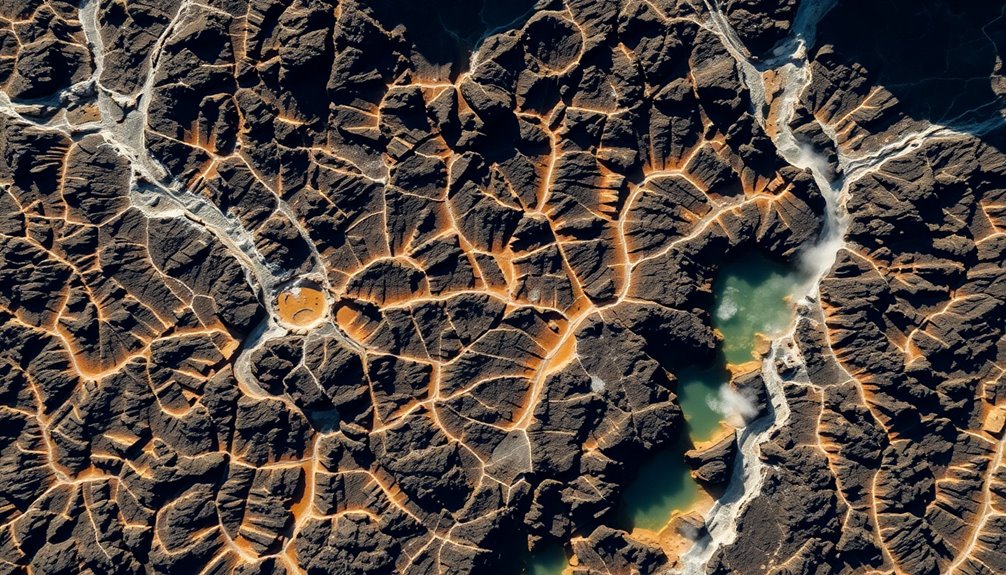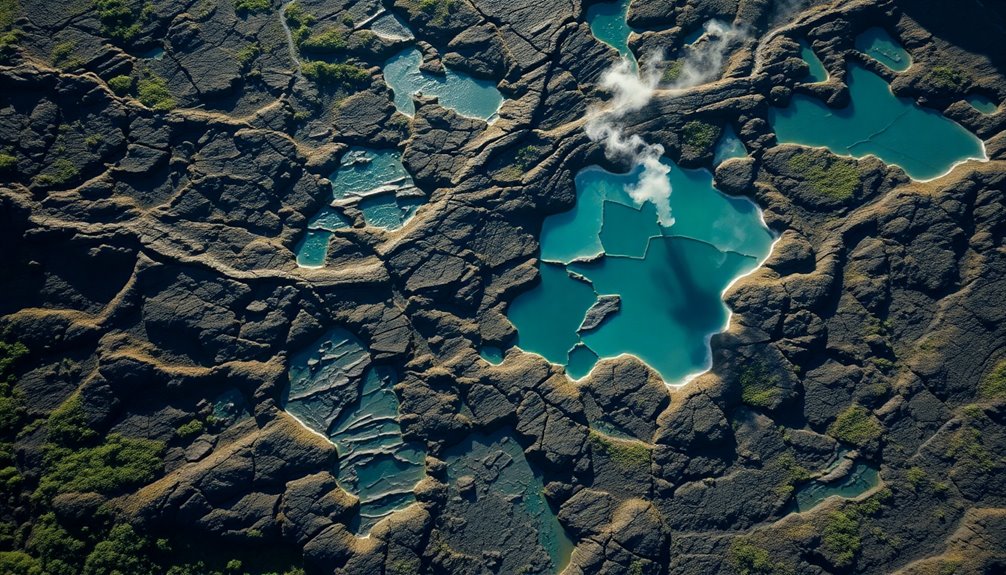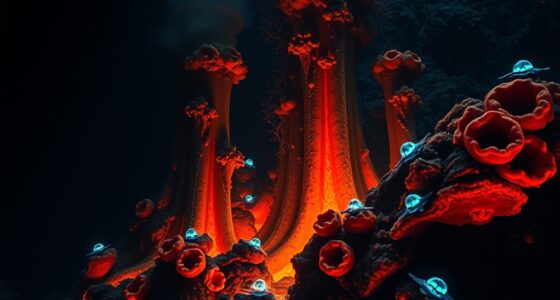Fracture networks play a crucial role in enhancing geothermal systems by improving heat extraction efficiency. Denser networks can boost performance significantly, while longer primary fractures aid fluid circulation. The orientation and distribution of fractures impact heat transfer and fluid flow. By optimizing fracture spacing and quantity, you can balance efficiency and extraction area. Multi-disciplinary simulations highlight these factors' importance and reveal effective strategies for maximizing system performance. There's more to uncover about the intricate dynamics of these networks.
Key Takeaways
- Multi-disciplinary simulations reveal that denser fracture networks enhance heat extraction efficiency in geothermal systems.
- Optimizing fracture orientation and distribution is essential for minimizing interference and maximizing fluid flow.
- Complex fracture patterns improve cold water circulation, leading to better heat transfer and reduced thermal decline.
- Discrete Fracture Network models effectively simulate fracture geometries, aiding in accurate predictions of thermal performance.
- Balancing the number and spacing of fractures is crucial to achieving optimal geothermal system performance without diminishing returns.

When you explore geothermal systems, understanding fracture networks is crucial to maximizing heat extraction efficiency. Denser networks of fractures significantly boost heat extraction performance and extend system lifetimes. You'll find that longer primary fracture lengths facilitate better fluid circulation, which enhances overall geothermal system efficiency.
The orientation and distribution of these fractures also play a vital role in influencing fluid flow and heat transfer, ultimately impacting performance. Complex fracture networks with higher connectivity offer more pathways for fluid flow, improving heat extraction. However, it's important to be aware of the effects of fracture interference; narrower spacing can lead to increased interference, which reduces efficiency due to higher injection pressures. Additionally, denser fracture networks can enhance heat extraction performance and extend system lifespan.
The orientation and spacing of fractures are crucial for optimizing fluid flow and enhancing heat extraction efficiency in geothermal systems.
To optimize heat extraction, you need to design these networks properly to enhance fluid circulation and heat transfer. With complex networks, you can maintain stable production temperatures, which are essential for effective heat extraction. The increased number of fractures provides more flow pathways, enlarging the heat extraction area and lowering injection pressures.
Cold water circulates more efficiently through these intricate networks, promoting better heat transfer from hot rock. As a result, thermal decline in the reservoirs slows down, maintaining productivity for longer periods.
Discrete Fracture Network (DFN) models serve as valuable tools for predicting heat and mass flow in geothermal systems. They help simulate fracture geometries and properties that significantly affect fluid flow and heat extraction. By capturing essential fracture properties like size, orientation, and intensity, DFN models enable you to represent complex geometric patterns critical for enhanced geothermal systems.
Accurate simulations aid in optimizing fluid circulation and improve predictions of thermal performance. Lastly, remember that spacing and number of fractures matter. Wider spacing reduces interference, while increasing the number of fractures expands the heat extraction area, enhancing overall efficiency.
As you approach performance saturation, the benefits of additional fractures will diminish, so it's crucial to reach the right balance for optimal system performance.
Frequently Asked Questions
How Are Fracture Networks Mapped in Geothermal Systems?
Fracture networks in geothermal systems are mapped using several techniques. You might use unmanned aerial vehicles (UAVs) to capture high-resolution images of inaccessible areas.
Microseismic mapping helps infer subsurface geometries during stimulation. Well testing assesses hydraulic properties, while fluid logging detects active fractures.
Additionally, numerical simulations, like discrete fracture network models, allow you to simulate complex geometries and understand their impact on heat extraction. Each method provides valuable insights into the system's functionality.
What Tools Are Used for Multi-Disciplinary Simulations?
When you're looking at multi-disciplinary simulations, several tools come into play.
Basin modeling software like TemisFlow™ assesses sedimentary heterogeneity, while reservoir simulation tools like PumaFlow™ predict fluid behavior.
You'll also find 3D geomodeling crucial for visualizing subsurface architecture.
Open-source options, like the Waiwera Simulator, enhance large model simulations, and GEOPHIRES helps with economic feasibility assessments.
These tools collectively improve resource assessment and reservoir management, making your geothermal projects more efficient.
How Do Fracture Networks Affect Geothermal Energy Production Efficiency?
Imagine tapping into the Earth's core, where fracture networks serve as your pathways to geothermal energy.
These networks boost production efficiency by enhancing fluid flow and heat extraction. Wider fractures increase heat access, while complex patterns create smoother pathways, ensuring consistent temperature outputs.
The right fractures lead to better permeability and injectivity, allowing for efficient heat recovery.
What Are the Environmental Impacts of Enhancing Geothermal Systems?
Enhancing geothermal systems can have several positive environmental impacts.
You'll notice reduced greenhouse gas emissions, as geothermal energy generates minimal pollutants compared to fossil fuels.
Using non-potable water sources for operations minimizes the strain on freshwater resources.
However, you should be aware of the potential for induced seismicity from fluid movement.
How Does Climate Change Influence Geothermal System Performance?
You might think climate change has little impact on geothermal systems, but that's not true.
Rising temperatures reduce the efficiency of these systems, making it harder to generate electricity effectively. It's crucial to adjust cooling systems and optimize operations to counteract these effects.
Furthermore, as the levelized cost of electricity increases, you'll need to embrace innovative technologies and diversify energy sources to ensure geothermal systems remain viable in a changing climate.
Conclusion
In the intricate dance of geothermal systems, fracture networks pulse like veins, channeling energy beneath the Earth's surface. By understanding and enhancing these networks, you unlock the potential to tap into powerful reservoirs of heat, turning the ground into a vibrant source of renewable energy. Picture the steam rising, the earth's warmth radiating, and your efforts transforming barren landscapes into thriving ecosystems. Embracing multi-disciplinary simulations, you're not just observing; you're sculpting a sustainable future with every fracture you explore.






